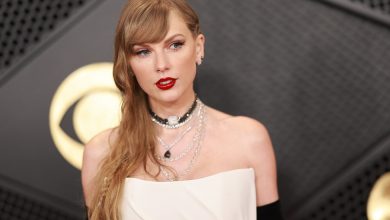No Ordinary Joe

Joe Brainard sought to take up as little space as possible. He specialized in small-scale works — collages, drawings, and occasional paintings that relate more to the proportions of a writer’s desk than an artist’s looming studio. “There is something I lack as a painter that de Kooning and Alex Katz have,” he jotted in his diary in 1967. “I wish I had that. I’d tell you what it was except that I don’t know.”
However much he may have lamented his perceived shortcomings, Brainard was ahead of his time in acknowledging his feelings of marginalization. Unable or unwilling to advance the grand tradition of painting, he created a major body of work by questioning the prevalent belief that artists should have an instantly recognizable, money-in-the-bank style. And he understood how cheapo things (comic books, cigarette packaging, gift tags, restaurant receipts, etc.) can be an expression of authentic emotion.
“Joe Brainard: A Box of Hearts and Other Works,” a fascinating and substantial survey show at the Tibor de Nagy Gallery, on Manhattan’s Lower East Side, arrives right on time. It coincides with the publication of a new monograph on the artist by the critic John Yau, as well as with the much-praised Alex Katz retrospective at the Guggenheim Museum, in which Brainard happens to materialize as an unmistakable portrait subject. There he stands on the Guggenheim ramps, in two painted sculptures from 1966, a rangy, slightly nerdy young man with curly brown hair, tortoiseshell glasses and an oversized shirt collar jutting from his V-neck sweater.
Brainard, a reticent Oklahoman who died of AIDS in 1994, at the age of 52, grew up in Tulsa and was an essential member of the second generation of the New York School. He arrived in Manhattan in 1960, and fell in with what was probably the last group of artists and writers to flourish in the city without any money. The poet Tony Towle, a former roommate of his, recalled that Brainard set up his studio in his bedroom and traded small collages for rent. Over time, he helped design covers for more than 100 books and small magazines published by his friends and came to exemplify the spirit of collaboration that defined his era. An occasional writer, he eventually brought out an acknowledged literary classic of his own: “I Remember,” a deceptively simple autobiography in which he relates his Midwestern childhood and discovery of sex as a series of 1,500 unconnected recollections that begin with the same two words — I remember — and have a cumulative incantatory power.
You can dip in on any page and be amused: “I remember ponytails … I remember always losing one glove … I remember that the red Crayola was always the first to go.”
The exhibition at Tibor de Nagy brings together 68 works from the 1960s and ’70s that range restlessly across mediums. The showstopper is no doubt “Untitled (Toothbrushes),” from 1973-4, a petite, mossy-green painting that invites close looking. The subject is almost ostentatiously humble: Three toothbrushes hang from a rack, as a fourth one with a red rubber tip lies horizontally across the top. The upright toothbrushes — as evenly spaced as Monet’s poplar trees —— structure the air around them and provide evidence that Brainard, at heart, was a stickler for classical order.
He also had a yen for portraiture. He frequently asked friends to pose for him, and the show at Tibor includes a rarely shown pencil sketch of Jasper Johns, one of Brainard’s artist-heroes. It was done in 1972, when Johns was in his hirsute middle age. He appears in the waist-length portrait as a shaggy-haired and bearded figure whose energy is concentrated in his wide, hypervigilant eyes.
Brainard’s output was so extensive that he made headlines in 1975 with a show at the Fischbach Gallery that was said to include more than 1,500 works. The quality of his work is uneven, and everyone has different favorites. My own are his pansy collages, tightly packed, edge-to-edge congeries of overlapping floral faces that give off a bright radiance as well as well as a sense of menacing, staring eyes. In this they share a bond with Ernie Bushmiller’s cartoon character Nancy, who has black discs for eyes and gazes unblinkingly from Brainard’s most memorable collages.
The show at Tibor possibly holds a record in its concentration of cigarette-themed works, harking back to an era when everyone lingered over 50-cent cups of coffee, a cigarette in hand. “My Brand,” Brainard wrote in black ink on a sheet of white paper, beneath a crisp line drawing of a crumpled pack of Tareytons. In truth, his taste in cigarettes was promiscuous. One small collage is dominated by a red-and-white Marlboro box that has been flattened into a full-frontal polygon, while another untitled collage, slightly larger, turns the Lucky Strike target into the hot-red center of a dark cosmos.
The artist’s affection for smoking achieves its most pithy expression in “I Met You” (1978), which consists of an open matchbook whose commercial message has been whited out, except for the three words of the title. Two remaining matches stand side by side, looking inexplicably couple-ish.
Brainard’s 1975 show at Fischbach turned out to be his last in New York; he abruptly withdrew from the commercial art world. Unlike Marcel Duchamp, whose fame increased when he announced he was giving up art for chess, Brainard’s abdication was not a Dadaist gesture. The poet Ron Padgett, who published an affecting memoir of Brainard in 2004, recalls a period of artistic crisis in which “he took an increasingly dim view of his work.” Overly conscious of his deficiencies, he signed up for classes at the New York Academy of Art. His remaining years were given over to reading novels.
In the three decades since Brainard’s death, the interest in his work has only increased. Last year, the Metropolitan Museum of Art received a gift of 16 of his best works, including “Prell,” an assemblage that incorporates a dozen shapely shampoo bottles; and “Whippoorwill,” a small, velvety painting of a long-limbed whippet reclining on a green couch. Altogether the Met owns 42 of Brainard’s works, the largest number of any museum.
I had heard on the grapevine that the Met was about to display its impressive Brainard holdings, but the plan has not gelled. So we will just have to wait. Or, to put it in Brainardspeak, I remember … thinking that a Brainard show at the Met would be incredible.
Joe Brainard: A Box of Heart and Other Works
Through Dec. 3 at Tibor de Nagy, 11 Rivington Street, Manhattan; 212-262-5050, tibordenagy.com.



